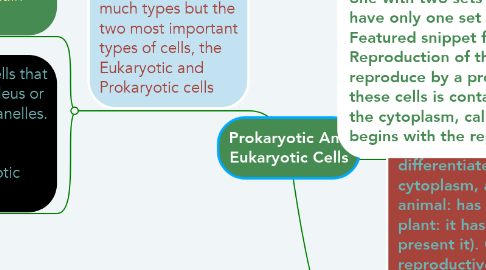Prokaryotic And Eukaryotic Cells
by David Santiago Cubides Ferreira

1. The cells have to much types but the two most important types of cells, the Eukaryotic and Prokaryotic cells
1.1. Eukaryotic cells are cells that contain a nucleus and organelles, and are enclosed by a plasma membrane. Organisms that have eukaryotic cells include protozoa, fungi, plants and animals. These organisms are grouped into the biological domain Eukaryota.
1.1.1. Eukaryotic cell part:
1.2. Prokaryotic cells are cells that do not have a true nucleus or membrane-bound organelles. Organisms within the domains Bacteria and Archaea have prokaryotic cells.
1.2.1. Prokaryotic cell part:
2. Eukaryotic Cells:The eukaryotic cell has a differentiated nucleus, plasma membrane, cytoplasm, and DNA. ... animal: has centrosome (presented by animals) plant: it has chloroplasts and cell wall (plants present it). Cell division process, typical of reproductive cells, in which the number of chromosomes is reduced by half. Mitosis is used for almost all of your body's cell division needs. By definition, meiosis in humans is a process of cell division that takes us from a diploid cell, one with two sets of chromosomes, to haploid cells, which have only one set of chromosomes.
3. Interesting data: Prokaryotic cells: A type of cell that does not have a defined cell nucleus is called prokaryote, so its genetic material is free in the cell cytoplasm. ... Organisms whose cells are prokaryotic are known as prokaryotes and are usually primitive, single-celled, and smaller organisms. Mitosis is used for almost all of your body's cell division needs. By definition, meiosis in humans is a process of cell division that takes us from a diploid cell, one with two sets of chromosomes, to haploid cells, which have only one set of chromosomes. Search results Featured snippet from the Web Reproduction of the Prokaryotic Cell. Prokaryotic cells reproduce by a process called binary fission. The DNA in these cells is contained on a single circular chromosome in the cytoplasm, called a plasmid. The reproductive process begins with the replication of the chromosome.


